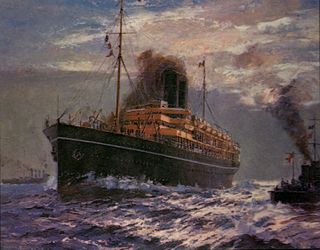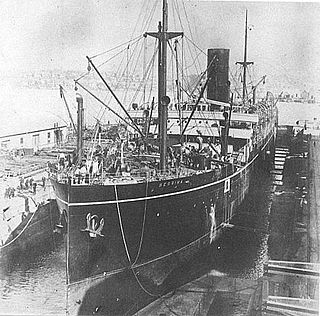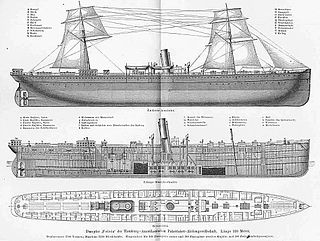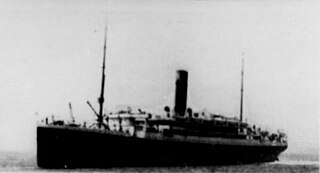
RMS Arlanza was a 14,622 GRT ocean liner of the Royal Mail Steam Packet Company. She was built in Belfast in 1912 for RMSP's scheduled route between England and South America. She was a Royal Navy armed merchant cruiser from 1915 until 1920. She returned to civilian liner service in 1920 and was scrapped in 1938.

RMS Alcantara was a Royal Mail Lines ocean liner that was built in Belfast in 1926. She served in the Second World War first as an armed merchant cruiser and then a troop ship. She returned to civilian service in 1948 and was scrapped in 1958.

RMS Rhone was a UK Royal Mail Ship owned by the Royal Mail Steam Packet Company (RMSP). She was wrecked off the coast of Salt Island in the British Virgin Islands on 29 October 1867 in a hurricane, killing 123 people. She is now a popular Caribbean wreck dive site.

RMS Amazon was a wooden three-masted barque, paddle steamer and Royal Mail Ship. She was the first of 5 sister ships commissioned by the Royal Mail Steam Packet Company to serve RMSP's routes between Southampton and the Caribbean.

The Royal Mail Steam Packet Company was a British shipping company founded in London in 1839 by a Scot, James MacQueen. The line's motto was Per Mare Ubique. After a troubled start, it became the largest shipping group in the world in 1927 when it took over the White Star Line. The company was liquidated and its assets taken over by the newly formed Royal Mail Lines in 1932 after financial trouble and scandal; over the years RML declined to no more than the name of a service run by former rival Hamburg Süd.

RMS Atrato was a UK steamship that was built in 1888 as a Royal Mail Ship and ocean liner for the Royal Mail Steam Packet Company. In 1912 she was sold and became the cruise ship The Viking. Late in 1914 she was requisitioned and converted into the armed merchant cruiser HMS Viknor. She sank in 1915 with all hands, a total of 295 Royal Navy officers and men.

RMS Medina was an ocean liner built by Caird and Company, Greenock, Scotland, in 1911, for the Peninsular and Oriental Steam Navigation Company. She was a Royal Mail Ship intended for use on the London to Australia route and was the last of the ten ships in P&O's M-Class. Between November 1911 and February 1912 Medina took King George V and Queen Mary to India for the Delhi Durbar. Medina was lost when she was torpedoed on 28 April 1917.
Teutonia was a screw steamer that was built by Caird & Company, Greenock, Renfrewshire, Scotland for the Hamburg Brazilianische Packetschiffahrt Gesellschaft in 1856. It later served with the Hamburg Amerika Line before being sold to British owners in 1877 and Italian owners in 1884, serving them under the names Regina, Piemontese, Città di Savona and Mentana The ship was scrapped in 1894.
RMS Magdalena was a British steamship that was built in 1889 as a Royal Mail Ship and ocean liner for the Royal Mail Steam Packet Company. In the First World War she served as the troop ship HMT Magdalena. After a long and successful civilian and military career she was scrapped in 1923.

Caird & Company was a Scottish shipbuilding and engineering firm based in Greenock. The company was established in 1828 by John Caird when he received an order to re-engine Clyde paddle-tugs.

The SS Silesia was a late 19th-century Hamburg America Line passenger and cargo ship that ran between the European ports of Hamburg, Germany and Le Havre, France to Castle Garden and later Ellis Island, New York transporting European immigrants, primarily Russian, Prussian, Hungarian, German, Austrian, Italian, and Danish individuals and families. Most passengers on this route were manual laborers, including stonecutters, locksmiths, farmers, millers, upholsterers, confectioners, and tailors, though physicians and other professionals also bought passage on her.

SS Calgaric was a steam ocean liner that was completed in 1917, assumes service in 1918 and scrapped in 1934. She was built for the Pacific SN Co Line as Orca. In 1923 she was transferred to the Royal Mail Line. In 1927 she was transferred to White Star Line and renamed Calgaric.

SS (RMS) Tynwald (II), No. 45474, was an iron paddle-steamer which served with the Isle of Man Steam Packet Company, and was the second vessel in the Company to bear the name.
Numerous vessels have borne the name Coromandel, named for the Coromandel Coast.

RMS Asturias was a Royal Mail Steam Packet Company ocean liner that was built in Ireland in 1908 and scrapped in Japan in 1933. She was a Royal Mail Ship until 1914, when on the eve of the First World War the British Admiralty requisitioned her as a hospital ship.

RMS Amazon was a transatlantic Royal Mail Ship that the Royal Mail Steam Packet Company operated on scheduled services between Southampton and South American ports including Buenos Aires. She was the second of the RMSP's fleet of "A" series liners, and was launched in 1906.
RMS Douro was a British passenger liner that served from 1865 to 1882 with the Royal Mail Steam Packet Company. She was sunk in a collision in 1882.

RMS Asturias was a Royal Mail Lines ocean liner that was built in Belfast in 1925. She served in the Second World War as an armed merchant cruiser until she was crippled by a torpedo in 1943. She was out of action until 1948 when she returned to civilian service as an emigrant ship. She became a troop ship in 1954 and was scrapped in 1957.
SS Potaro was a refrigerated cargo steamship that was built in Belfast in 1904, and captured and scuttled in the First World War in 1915.
RMS Orinoco was a British Royal Mail Ship that was built in Scotland in 1886 and scrapped, also in Scotland, in 1909. She spent her entire career with the Royal Mail Steam Packet Company (RMSP), mainly trading between England and the Caribbean.














